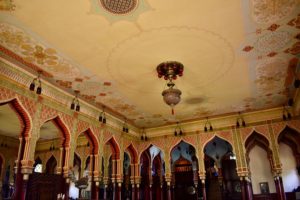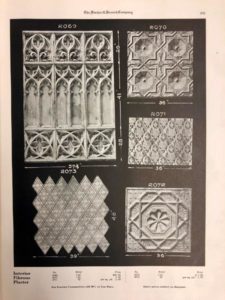William Sauntry’s “Moorish Palace”: The Alhambra’s Influence on American Architecture
EMERGING SCHOLARS > SUMMER RESEARCH GRANTS
Elizabeth Humphrey,
Winterthur Program in American Material Culture, University of Delaware
This summer I explored a large and unassuming recreation-hall-turned-private-home in Stillwater, MN (Figure 1). Painted stucco covered the exterior walls with subtle traces of Islamic design in an alternating pattern on the window surrounds known as an ablaq. Half of a finialed onion dome was affixed above the rear entrance. As I documented and photographed these architectural features, I questioned whether I was in the right place. Little did I know, I was about to enter an elaborate allusion to a Moorish architectural monument: the Alhambra Palace in Granada, Spain.
The recreation hall was built in 1902 for the ‘King of the St. Croix,’ William Sauntry, a local lumber baron who at the height of his career amassed a fortune close to $2,000,000 (nearly $60,000,000 today). Chicago architectural firm Wilson & Marshall designed Sauntry’s hall. Although the architectural drawings from their partnership no longer survive, archives of Marshall’s later designs suggest that the firm was responsible for creating plans for the interior and exterior. The hall was an ostentatious display of wealth, originally connected to Sauntry’s earlier Victorian mansion by a second-floor breezeway, and leading to a grand double staircase that flowed out into the reception area and ballroom (Figure 2). An indoor swimming pool and bowling alley were also featured in this single-floor addition, which functioned as a site of leisure, fitness, and entertainment. The St. Paul Globe recalled Mrs. Sauntry’s use of the recreation hall for several progressive euchre tournaments accompanied by orchestral music.
How does one begin to understand this space as a representation of the Moorish Revival, and specifically Alhambresque design? Seen in the restored space today, the recreation hall’s design, original to 1902, has the flair of the Moorish Revival in the 19th- and 20th-century, a reflection of America’s fascination with Orientalism. Vibrant red, gold, and blue hues cover the ballroom walls, complementing the warm tones of the five stained-glass windows around the room, as an original border of 24 ogee arches surrounds the ballroom (Figure 2). Wooden columns support each archway, featuring shell and foliate capitals.
Although the entire hall is a Moorish-inspired design, the material qualities of Sauntry’s ballroom directly express the connection to the famed palace complex in Granada. The plaster wall treatments are uniform, indicating that the decorative façade was created with composition ornament (Figure 3) that was available to Wilson & Marshall or the builder William Biegung. Plasterwork firms circulated Alhambra-derived architectural details through trade catalogs, like the panels advertised in Fischer & Jirouch’s 1931 catalog (Figure 4). The gold capitals draw one’s eye up to the vertical calligraphic inscriptions, painted with similar gilded tones set against the red and pale-blue backgrounds. The capitals’ color scheme and decorative works recall drawings found in Owen Jones’ Details of the Alhambra (1834–1842). The architectural and ornamental features used in Sauntry Hall and their related design sources recall aspects of the Nasrid Palace, the 13th- and 14th-century section of the Alhambra, which house elaborate expressions of Moorish design and architecture.
I discovered Sauntry Hall’s connection to the Alhambra during a research trip funded in part by the Decorative Arts Trust. My thesis-in-progress considers the Alhambra’s influence on American architecture, highlighting an under-studied aspect of American material culture and decorative arts and revealing international influences found in American design.




